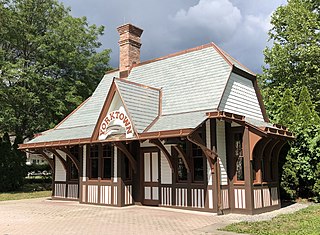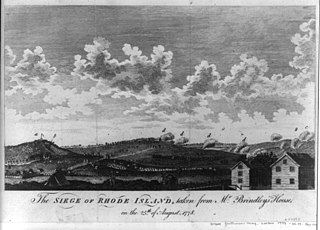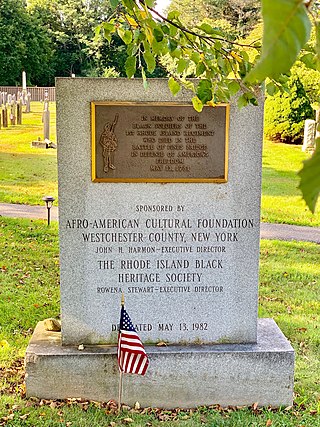
Yorktown is a town on the northern border of Westchester County, New York, United States. A suburb of the New York City metropolitan area, it is approximately 38 miles (61 km) north of midtown Manhattan. The population was 36,569 at the 2020 U.S. Census.

Yorktown Heights is a census-designated place (CDP) in the town of Yorktown in Westchester County, New York, United States. The population was 1,781 at the 2010 census.

The siege of Yorktown, also known as the Battle of Yorktown and the surrender at Yorktown, began September 28, 1781, and ended on October 19, 1781, at exactly 10:30 am in Yorktown, Virginia. It was a decisive victory by a combined force of the American Continental Army troops led by General George Washington with support from Marquis de Lafayette and French Army troops led by Comte de Rochambeau and a French naval force commanded by Comte de Grasse over the British Army commanded by British Lieutenant General Charles Cornwallis.

Major-General Nathanael Greene was an American military officer and planter who served in the Continental Army during the Revolutionary War. He emerged from the war with a reputation as one of George Washington's most talented and dependable officers, and is known for his successful command in the Southern theater of the conflict.

The Battle of Cowpens was an engagement during the American Revolutionary War fought on January 17, 1781 near the town of Cowpens, South Carolina, between American Patriot forces under Brigadier General Daniel Morgan and British forces, nearly half American Loyalists, under Lieutenant Colonel Banastre Tarleton, as part of the campaign in the Carolinas. The battle was a turning point in the American reconquest of South Carolina from the British.

The Battle of Springfield was fought during the American Revolutionary War on June 23, 1780, in Union County, New Jersey. After the Battle of Connecticut Farms, on June 7, 1780, had foiled Lieutenant General Wilhelm, Baron von Knyphausen's expedition to attack General George Washington's army at Morristown, New Jersey, Knyphausen and Lieutenant General Sir Henry Clinton, British commander-in-chief in North America, decided upon a second attempt. Although the British were initially able to advance, they were ultimately forced to withdraw in the face of newly arriving rebel forces, resulting in a Continental victory. The battle effectively ended British ambitions in New Jersey.

The 1st Rhode Island Regiment was a regiment in the Continental Army raised in Rhode Island during the American Revolutionary War (1775–83). It was one of the few units in the Continental Army to serve through the entire war, from the siege of Boston to the disbanding of the Continental Army on November 3, 1783.

The Battle of Rhode Island took place on August 29, 1778. Continental Army and Militia forces under the command of Major General John Sullivan had been besieging the British forces in Newport, Rhode Island, which is situated on Aquidneck Island, but they had finally abandoned their siege and were withdrawing to the northern part of the island. The British forces then sortied, supported by recently arrived Royal Navy ships, and they attacked the retreating Americans. The battle ended inconclusively, but the Continental forces withdrew to the mainland and left Aquidneck Island in British hands.

The Rhode Island Line was a formation within the Continental Army. The term "Rhode Island Line" referred to the quota of numbered infantry regiments assigned to Rhode Island at various times by the Continental Congress. These, together with similar contingents from the other twelve states, formed the Continental Line. The concept was particularly important in relation to the promotion of commissioned officers. Officers of the Continental Army below the rank of brigadier general were ordinarily ineligible for promotion except in the line of their own state.

The siege of Yorktown was the culminating act of the Yorktown campaign, a series of military operations occupying much of 1781 during the American Revolutionary War. The siege was a decisive Franco-American victory: after the surrender of British Lt. Gen. Charles, Earl Cornwallis on October 17, the government of Lord North fell, and its replacement entered into peace negotiations that resulted in British recognition of American independence with the 1783 Treaty of Paris.

The Battle of Red Bank, also known as the Battle of Fort Mercer, was a battle fought on October 22, 1777, during the American Revolutionary War. A British and Hessian force was sent to take Fort Mercer on the New Jersey side of the Delaware River just south of Philadelphia, but was decisively defeated by a smaller force of Continental Army troops.

The South Side of Providence, Rhode Island, originally South Providence, is a term frequently used to describe the collective region comprising the official neighborhoods of Upper and Lower South Providence, Elmwood and the West End. The name was first used in the 1830s when the New York, Providence and Boston Railroad established its first station at a pier on the Providence River on a point of land about one half mile south of downtown Providence. The station was named South Providence.

In the American Revolution, gaining freedom was the strongest motive for Black enslaved people who joined the Patriot or British armies. It is estimated that 20,000 African Americans joined the British cause, which promised freedom to enslaved people, as Black Loyalists. Around 9,000 African Americans became Black Patriots.

The Battle of Rhode Island Site is the partially preserved location of the Battle of Rhode Island, fought August 29, 1778 during the American Revolutionary War. The battle took place in the town of Portsmouth, Rhode Island, located on Aquidneck Island north of Newport, and was the only major action of the war that took place in Rhode Island. It was also significant as the only battle of the war in which an entirely segregated unit of African-American soldiers fought. At the time of the action, the 1st Rhode Island Regiment consisted of companies of locally recruited African Americans and Native Americans with white officers. The two main areas associated with the battle were designated a National Historic Landmark in 1974.

The Battle of Blandford, also called the Battle of Petersburg, took place near Petersburg, Virginia on 25 April 1781, late in the American War of Independence. Roughly 2,300 British regulars under the command of Brigadier General William Phillips defeated about 1,000 militia under Major General Baron von Steuben.

The Red Bank Battlefield is located along the Delaware River in National Park, Gloucester County, New Jersey. It was the location of the Battle of Red Bank in the American Revolutionary War on October 22, 1777. Fort Mercer and its sister, Fort Mifflin in Pennsylvania, defended the river and prevented the British from using it for transportation. The forts successfully delayed the British, but in the end, they were both destroyed or abandoned.

Christopher Greene was an American legislator and soldier. He led the spirited defense of Fort Mercer in the 1777 Battle of Red Bank, and for leading the African American 1st Rhode Island Regiment during the American Revolutionary War, most notably with distinction in the 1778 Battle of Rhode Island. He was killed in May 1781 at the Battle of Pine's Bridge by Loyalists, possibly because he was known to lead African American troops.
Jeremiah Olney was born into an old family from Rhode Island. He formed a company of infantry from that state at the start of the American Revolutionary War. After serving as captain in 1776, he was promoted to lieutenant colonel at the beginning of 1777. As second-in-command of the 2nd Rhode Island Regiment, he fought at Red Bank. After its commander was wounded early in the action, he led Varnum's brigade in bitter fighting at Monmouth in June 1778.

The Monument to the 1st Rhode Island Regiment at Yorktown Heights, New York was erected on May 13, 1982, on the grounds of the First Presbyterian Church to commemorate the valiant efforts of a Revolutionary War unit composed predominantly of black soldiers that fought on May 14, 1781, under the command of Colonel Christopher Greene.















